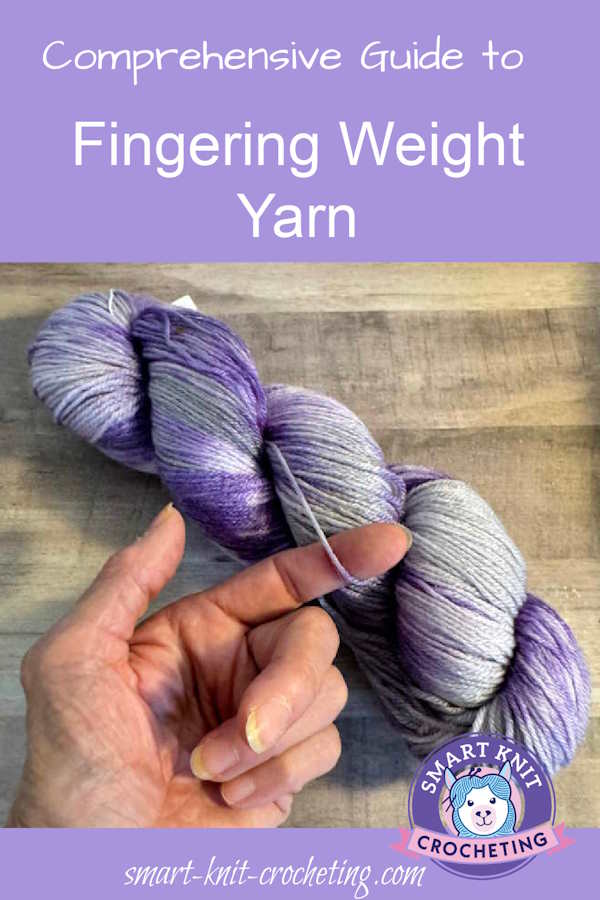- Home
- Fingering Weight Yarn
Fingering Weight Yarn: Everything You Need to Know
Fingering weight yarn, also known as sock yarn, is famous for knitters and crocheters of all skill levels. Its versatility, drape, and stitch definition suit various projects, from delicate lace shawls to durable socks.
This comprehensive guide will delve into the history, characteristics, and uses of fingering weight yarn, equipping you with the knowledge to choose and work with this beloved yarn weight confidently.
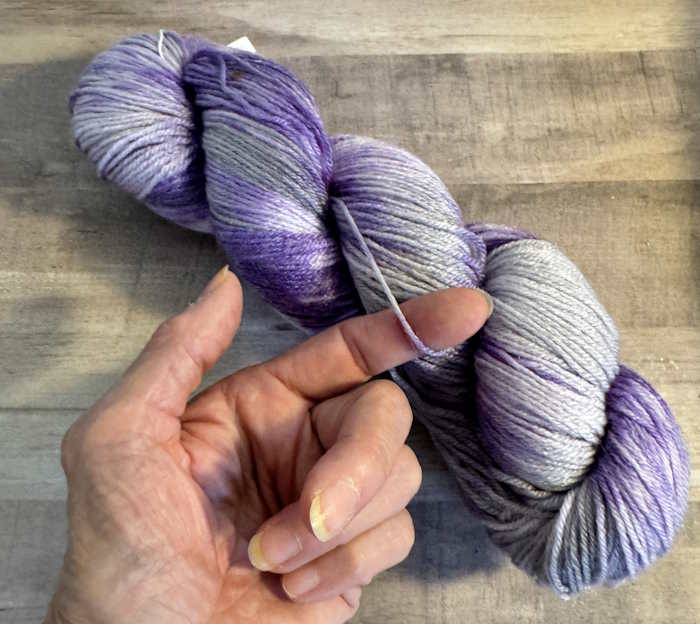
A Brief History of Fingering Weight Yarn
Before standardizing yarn weights, knitters relied on visual and tactile cues to determine a yarn's thickness. The term "fingering weight" likely originated from comparing yarn strands to the width of one's fingers. This traditional method, while subjective, highlights the long-standing connection between hand-crafted textiles and the human experience.
The 20th century saw the rise of industrial yarn production and a growing need for consistent yarn classification. The Craft Yarn Council (CYC), established in 1982, introduced a standardized system using numbered categories to represent different yarn weights.
Defining Fingering Weight Yarn
Fingering weight yarn typically refers to yarns with a thickness ranging from 14 to 22 wraps per inch (WPI). This measurement, taken by wrapping the yarn loosely around a ruler, offers a practical way to identify yarn weight. However, it's important to note that WPI can vary slightly depending on the yarn's fiber content and construction.
Fingering weight yarn falls into the "fine" category of yarn weights, typically characterized by a weight number of #1. It's thinner than worsted-weight yarn (the most common type) but thicker than lace-weight yarn.
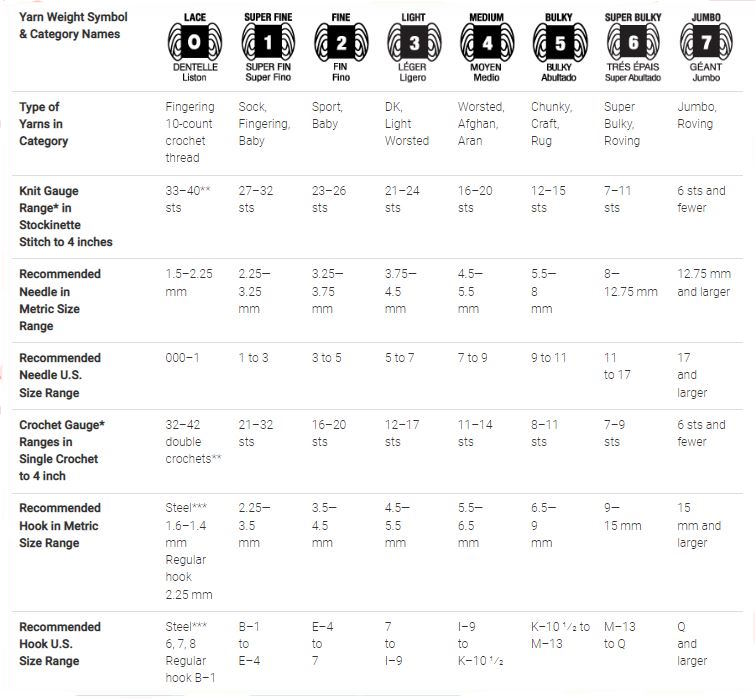
Characteristics
Weight/Thickness: #1 Super Fine/Sock weight, Baby
Recommended Hook Size: 2.25mm - 3.5mm (US sizes B - E)
Crochet Gauge: Around 28-32 stitches per 4 inches in single crochet (varies by yarn)
Recommended Needle Size: 2.25mm to 3.25mm (US 1 - 3)
Knitting Gauge: 27 - 32 stitches in stockinette per 4 inches
Yardage: High yardage, typically around 350-450 yards per 100g skein.
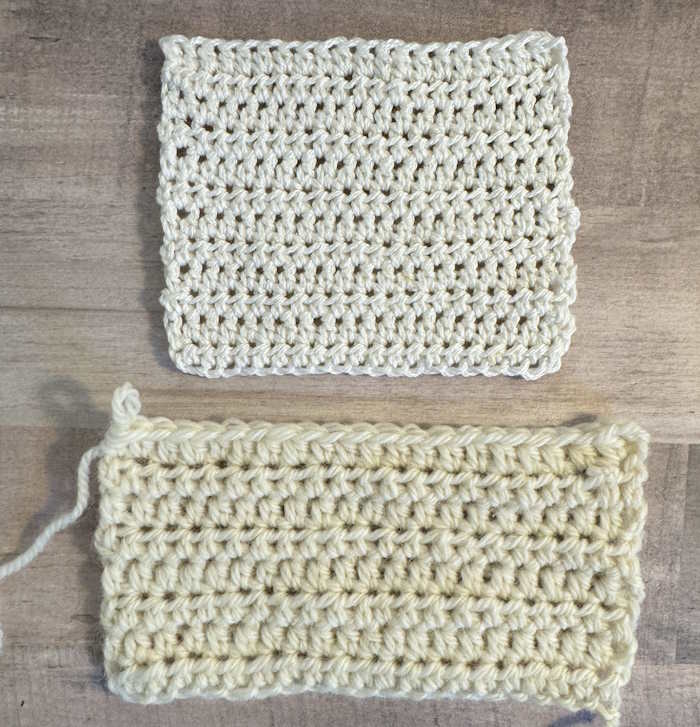 Half-double crochet Swatches (one with fingering-weight yarn and one with worsted-weight yarn) are both worked on 20 chain stitches.
Half-double crochet Swatches (one with fingering-weight yarn and one with worsted-weight yarn) are both worked on 20 chain stitches.Pros of Using Fingering Weight Yarn:
- Versatility: Suitable for various projects, from delicate lacework to warm garments.
- Drape: Creates beautiful drape in garments and accessories.
- Stitch Definition: Shows off intricate stitch patterns beautifully.
- Durability: Many fingering-weight yarns, especially sock yarns, are designed to be durable and long-lasting.
Cons of Using Fingering Weight Yarn
- Time-Consuming: Projects take longer to complete due to the thinner yarn.
- Splitting: Some fingering-weight yarns are prone to splitting, making them slightly trickier for beginners.
- Tension: Requires consistent tension to maintain even stitches.
- Learning Curve: If you are accustomed to using worsted or heavier yarn, switching to a fingering weight yarn can feel very different.
Key Characteristics: Fiber Content
Fingering weight yarn comes in diverse fibers, each imparting unique properties to the finished project. Common options include:
Wool: Known for its warmth, elasticity, and moisture-wicking properties, wool is a classic choice for socks, sweaters, and accessories.
Cotton: Breathable and absorbent, cotton is ideal for lightweight garments, baby items, and summer projects.
Linen: Strong and durable, linen offers a beautiful drape and a characteristically crisp hand. It's often used for warm-weather garments and home décor items.
Silk: Luxurious and lustrous, silk adds a touch of elegance to any project. It's often blended with other fibers to create yarns with exceptional drape and sheen.
Bamboo: Soft, drapey, and naturally antibacterial, bamboo is a popular choice for garments and accessories worn close to the skin.
Learn more about fiber content.
Key Characteristics: Construction
Ply: The number of plies, or individual strands of yarn twisted together, influences a yarn's strength, durability, and drape.
Fingering-weight yarns are typically available in 2-ply, 4-ply, or even higher-ply constructions.
Twist: The amount of twist applied to the yarn affects its elasticity, stitch definition, and overall texture. Tightly twisted yarns are more durable and have better stitch definition, while loosely twisted yarns create a softer, more drapey fabric.
What Can You Make with Fingering Weight Yarn?
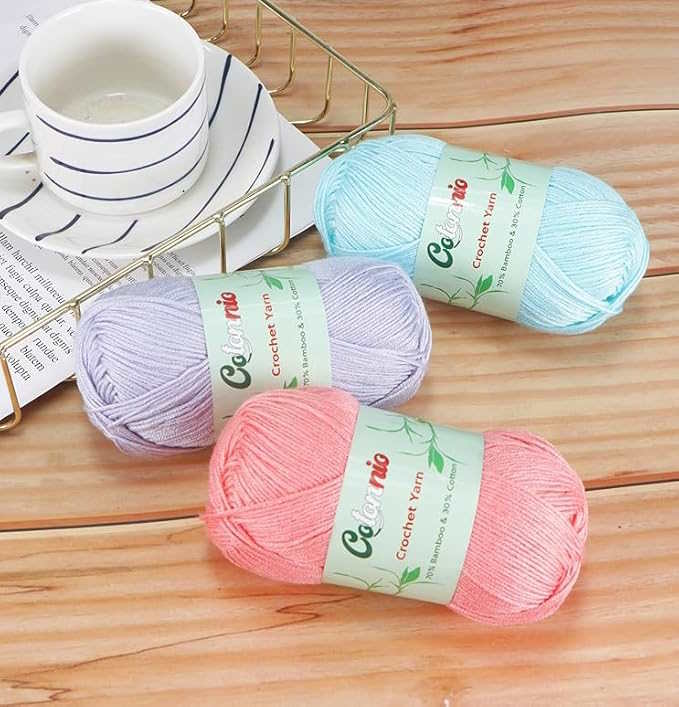
The versatility of fingering weight yarn makes it suitable for a wide range of knitting and crocheting projects. Here are some popular options:
Socks: As the name "sock yarn" suggests, this yarn weight is perfect for knitting or crocheting durable and comfortable socks. If you plan to use fingering-weight yarn for socks, look for labels marked as sock weight. That way, you will know the yarn is sturdy and intended for items meant to last. For interesting socks, look for self-striping sock yarn.
Shawls and Wraps: The fine gauge of fingering weight yarn creates beautifully draped and intricate lacework in shawls and wraps.
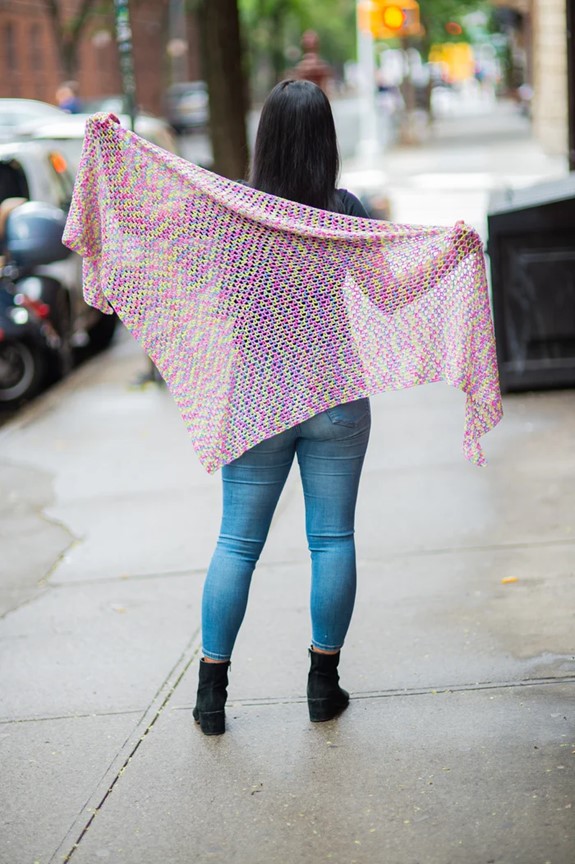
Sweaters and Cardigans: Fingering-weight yarn is an excellent choice for summer sweaters and cardigans. It is lightweight and breathable. The downside, of course, is the amount of time it will take you to complete a sweater. It is best to reserve fingering-weight yarn for baby clothes.
Baby Items: Fingering-weight yarn's softness and drape make it ideal for delicate baby blankets, sweaters, and hats. As a word of caution, read the label carefully. Baby yarns can be fingering-weight, but they can also be sports weight.
Hats: Fingering-weight yarn offers endless possibilities for hat designs, from cozy beanies to stylish slouchy hats.
Gloves and Mittens: Fingering-weight yarn is a practical choice for gloves and mittens because of its warmth and durability.
Blankets and Throws: While it may take much longer, a fingering-weight blanket offers exceptional drape and a luxurious feel. They make great lightweight blankets, perfect for cool summer nights.
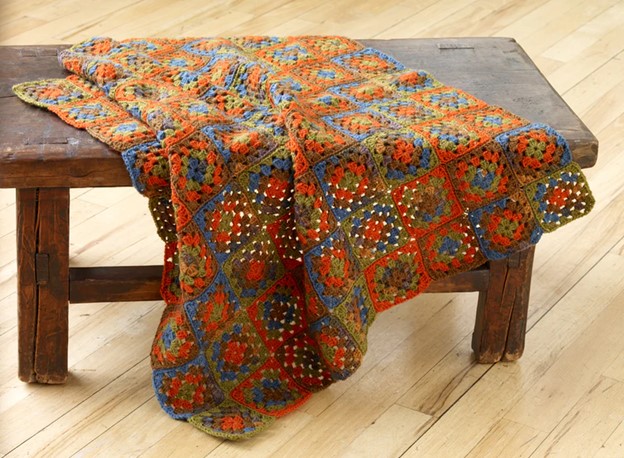
Shades Of Autumn Granny Throw Pattern
Crochet pattern using fingering weight yarn
Difficulty: Easy
Scarves and Cowls: Use fingering-weight yarn to Create intricate lace patterns or simple textured designs for stylish and cozy accessories.
Amigurumi: Results in smaller and more detailed amigurumi projects.
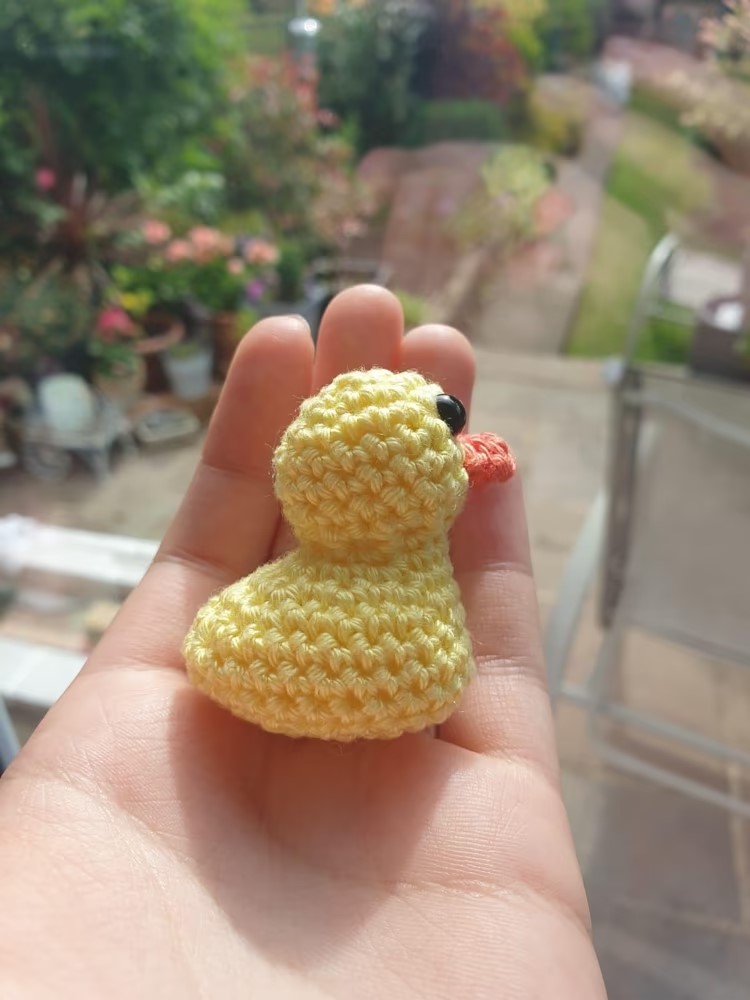
Factors to Consider When Purchasing Fingering Weight Yarn
Before investing in fingering weight yarn for your next project, consider the following factors:
- Fiber content: Choose a fiber that suits your project's requirements and personal preferences. When selecting, consider factors such as warmth, durability, ease of care, and drape.
- Yardage: Ensure you purchase enough yarn to complete your project by carefully checking the yardage requirements in your pattern and comparing them to the yardage of your chosen yarn.
- Color and dye lot: If your project requires multiple yarn skeins, purchase skeins from the same dye lot to ensure color consistency. Hand-dyed yarns may have more variation between skeins, so it's essential to alternate skeins while working to blend any differences.
- Care instructions: Check the yarn label for care instructions to ensure that you can properly maintain your finished project. Some fibers may require hand washing or dry cleaning, while others can be machine washed.
- Budget: Fingering weight yarns can vary significantly in price depending on the fiber content, brand, and manufacturing process. Determine your budget before shopping to help narrow down your options.
Examples of Less Expensive Fingering-weight yarn
If you want to dive into knitting or crocheting with fingering weight yarn for the first time and don’t want to spend $50 per hank, I’ve researched some inexpensive alternatives for you to investigate.
Estako Cotton Mercerized Crochet Knitting Yarn
Alpaca Drops Superfine Fingering Weight Yarn
Microfiber Acrylic Fingering Crochet Knitting Yarn
Lion Brand Fingering weight yarn
Crochet - Knitting Bamboo Superfine Fingering
Big Twist Baby Bunny by Joanns
Tips for Beginners
- Start with a Simple Pattern: Choose a pattern specifically designed for fingering weight yarn with clear instructions.
- Use the Recommended Hook or Needle Size: This will help you achieve the correct gauge and prevent your fabric from being too tight or too loose.
- Practice Your Tension: Consistent tension is crucial for a professional-looking finished product. If all you have ever used is bulky weight yarn, switching to a fine yarn weight may take some practice.
- Be Patient: Working with fingering weight yarn can be more time-consuming, so be patient and enjoy the process.
Conclusion
Fingering weight yarn offers a world of creative possibilities for knitters and crocheters. Its versatility, drape, and stitch definition make it suitable for various projects, from delicate lacework to durable everyday garments. By understanding the characteristics and considerations for choosing fingering weight yarn, you can confidently embark on your next knitting or crocheting adventure and create beautiful, handcrafted treasures.
Pin for Future Reference
About Janice
Hi, I’m Janice, the voice behind Smart-Knit-Crocheting. I love to knit and crochet and even more, I love teaching others what I know.
Though I learned to knit and crochet as a child, I didn’t get serious about these amazing hobbies until I retired. I’m a certified knit and crochet instructor through the Craft Yarn Council and am working on becoming a Master Hand Knitter through The Knitting Guild Association.
I’m currently living with my husband of over 50 years and our 6 Shih Tzu dogs.
I love hearing from you, so please drop me a line and let me know what you’re working on, whether you love knitting or crocheting more, and if you have any questions. Please visit my about me page for more information.
Happy Crocheting
